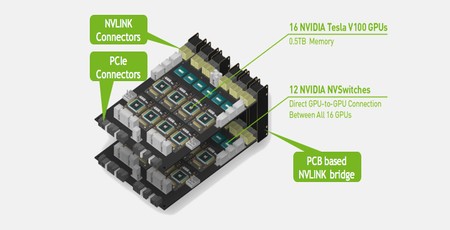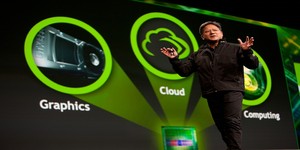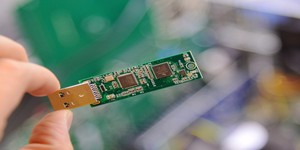
Nvidia has announced its latest cloud server platform, the HGX-2, which combines 16 Tesla V100 accelerator boards with six NVSwitch NVLink switches for deep learning and artificial intelligence workloads.
Announced just over a year after Nvidia unveiled the original HGX-1 hyperscale GPU accelerator platform, the HGX-2 switches the original's eight Tesla P100 accelerators out for 16 Tesla V100 accelerators - giving the device an impressive overall frame buffer of 512GB. Performance, too, has unsurprisingly dramatically increased: Doubling the number of GPUs combines with other improvements to translate to a real-world 4x to 5.4x performance boost when using one 16-GPU HGX-2 compared with two eight-GPU HGX-1s.
Chief among these improvements is a switch from the HGX-1's hybrid cube mesh layout to a full NVSwitch system based on Nvidia's NVLink interconnection technology. Where its predecessor could only allow four of the eight GPUs to communicate via NVLink, HGX-2 allows any of the 16 GPUs to communicate with any other GPU through NVLink without having to pass over PCI Express (PCIe) - which combines with a switch from one or two NVLink lanes to allow the use of six NVLink lanes, totalling 2,400GB/s of bisection bandwidth.
'The world of computing has changed,' claimed Jensen Huang, Nvidia founder and chief executive officer, at the GPU Technology Conference Taiwan late yesterday. 'CPU scaling has slowed at a time when computing demand is sky-rocketing. Nvidia's HGX-2 with Tensor Core GPUs gives the industry a powerful, versatile computing platform that fuses HPC and AI to solve the world’s grand challenges.'
In short, the HGTX-2 is a bit of a beast - powerful enough, the company claims, to replace 300 dual-CPU unaccelerated servers in a data centre. The company has industry backing, too: Lenovo, QCT, Supermicro, and Wiwynn have all announced plans to launch HGX-2 servers by the end of the year, along with original design manufacturers Foxconn, Inventec, Quanta, and Wistron.
Pricing, however, is very much on application, and thus far Nvidia is silent on when or if its NVSwitch and NVLink technology for many-GPU setups may make the jump out of the data centre and into high-end desktop (HEDT) products - though, given its recent defocussing from multi-card SLI support in its gaming products, enthusiasts could be waiting some time.
More information on the HGX-2 is available on the Nvidia developer blog.

MSI MPG Velox 100R Chassis Review
October 14 2021 | 15:04








Want to comment? Please log in.